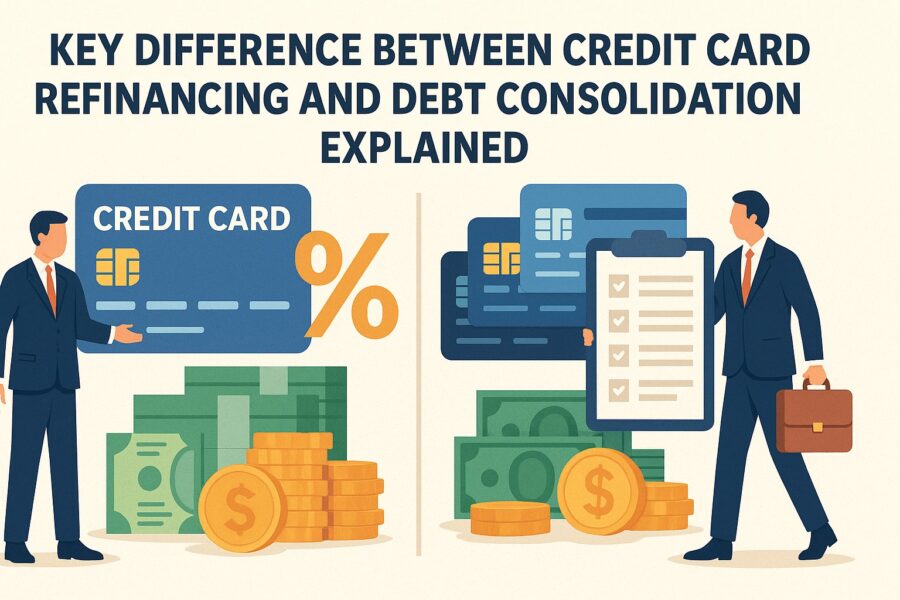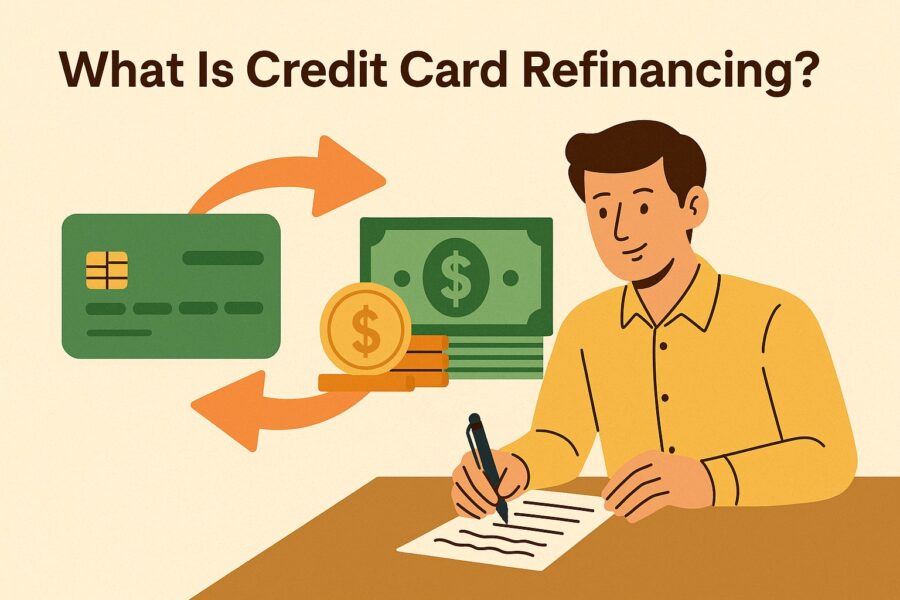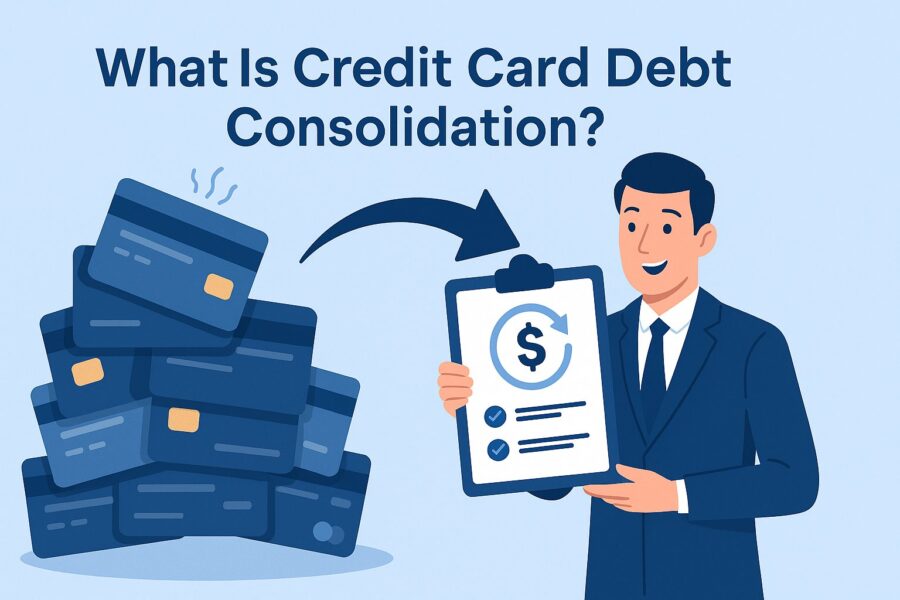Key Difference Between Credit Card Refinancing and Debt Consolidation Explained
- 17 Oct 25
- 9 mins

Key Difference Between Credit Card Refinancing and Debt Consolidation Explained
Key Takeaways
- Refinancing allows you to transfer existing credit card debt to a loan or card with a lower APR, helping save money on interest and pay off debt faster.
- By combining several debts into a single payment with one interest rate, debt consolidation helps manage finances more efficiently and avoid missed payments.
- Individuals with good credit (680+) can qualify for 0% APR balance transfer offers, maximizing interest savings and easing repayment stress.
- Consistent repayments on a consolidated loan can boost your credit score and help manage debt sustainably, provided no new debt is accumulated.
- Pick credit card refinancing if you aim to reduce interest on one or two high-rate cards; choose debt consolidation if you’re juggling multiple debts and want simplicity.
Managing debt on credit cards at times is stressful, particularly with high rates of interest and making multiple payments each month. During 2023, the U.S. credit card APR on average was more than 20%, making it costly for debt management. This is where the importance of credit card refinancing and debt consolidation comes in!
The main focus of refinancing is on reducing interest for the available balance, while consolidation combines multiple debts into a single payment. Familiarising yourself with the difference between credit card refinancing and debt consolidation lets you choose the right strategy for saving money and gaining control over your financial situation.
What Is Credit Card Refinancing?

Credit card refinancing is a method of paying off your credit card balance by opting for a loan or another credit card at a low interest rate. People often choose to refinance credit card debt to save money on interest costs and move out of debt burden quickly. Many people opt for a personal loan or a balance transfer credit card to meet this purpose.
For example, if your current existing credit card charges 36% APR, refinancing a card offering 0% APR during the first 12 months can let you save thousands in interest payments, provided you pay on time. The U.S. credit card APR on average during 2025 is 23.99%, making individuals choose refinancing as a smart choice.
Moreover, choosing the refinancing option enables individuals to clear debts faster, lower their monthly payments and improve their overall financial health. It works best if you refrain from adding more debt and opt for a fixed repayment plan.
Pros and Cons of Credit Card Refinancing
There are several benefits and drawbacks of credit card refinancing. Let’s explore them in detail.
Pros
1. Save on Interest Charges
Considering your existing balance on a credit card and the difference between the prevailing interest rates, you can save hundreds and thousands of dollars in interest charges through refinancing.
2. Get Out of Debt Faster
When you do not need to pay more or any interest on your existing debt, your monthly payments add up to the principal balance. This enables you to pay off the debt balance quicker, reducing your time in debt.
3. Gain Access to Promotional Rates
The majority of credit cards come with a promotional 0% APR for a particular timeframe. If you manage to pay off your debt balance within this period, you can avoid paying interest on debt.
4. Fewer Monthly Payments to Manage
Refinancing several credit cards and combining the debts into a single credit card or loan balance poses several benefits. You will make fewer payments for tracking each month.
Cons
1. Meeting Qualified Lenders and Limitations
There are several 0% APR credit cards available. However, they are only for individuals with excellent credit. As and when you apply for a new loan or credit card, the lender checks your credit and further verifies your employment history and income.
2. Impact on Credit Scores
Application for a new credit card or a loan for refinancing the debt on your credit card might initially reduce your credit score. This is because, while you apply for a credit, the bank conducts a hard credit check. The new account you have opted for will lower the average age of your accounts, one of the crucial factors that affect your credit score.
Who Should Consider Credit Card Refinancing?
Credit card refinancing is an ideal option for individuals paying high rates of interest and willing to save more money. If the current charges on your credit card are around 20% APR, shifting your available balance to a low-interest-rate credit card or loan can cut costs. For instance, opting for a balance transfer card with 0% APR applicable for 12-18 months provides you enough time to pay off debt without additional interest.
Consider refinancing a credit card if:
- You hold good credit, particularly maintaining a good credit score of 680 and higher.
- You can avail a high and adequate balance limit on the card for transferring your high-interest-rate credit cards to a new card.
- You are eligible to pay off what you owe on a 0% interest rate credit card during the initial period of 12-18 months.
- You aim to reduce your monthly bill payment, providing you with a better chance of paying off your debt smoothly.
However, refinancing is not always the best option when your credit score is low, as you may fail to secure good terms. It must also be disciplined, not using new credit card debt. Refinancing is better suited to borrowers who have good credit and are determined to use the time to pay off the debt.
💡Pay your credit card bills in an easy and secured way and experience smooth transactions with the PICE App.
What Is Credit Card Debt Consolidation?

Credit card debt consolidation is the process of consolidating your multiple credit card balances into a single payment or loan. Instead of making payments with several cards on different dates with high rates of interest, it's beneficial to make payments monthly at a lower rate.
Suppose you are a cardholder with balances of ₹2,000, ₹3,000 and ₹4,000 at 20% APR. You can opt for a personal loan at 12% APR to pay off the debt at 12% APR. This lowers the interest costs and enables easy management of payments.
As per the Federal Reserve, the U.S. credit card rates of interest on average were 22.8% during 2023. So, the consolidating process might let you save more. Moreover, it works best if you discard the old credit cards and focus more on repaying the new loan.
Pros and Cons of Debt Consolidation
Debt consolidation is a useful tool for people facing issues with several credit card payments. It comprises both the benefits and drawbacks. Let's find them in detail below:
Pros
1. Convenient and Simplified Payment
Instead of keeping track of several due dates, you can make a single payment monthly. This lets you stay stress-free and also reduces the risk of missing a payment.
2. Fast Payoff of Debt
With low rates of interest, most of your payment shifts towards the principal balance. This helps clear off the debt quicker.
3. Low Rates of Interest
If you are eligible for a balance transfer or personal loan, you can avail an interest rate much lower than the average APR applicable to credit cards. This way, you can also save money over time.
4. Well-Maintained Credit Score
Making payments on time consistently and lowering your credit utilisation helps boost your credit score in the long run.
Cons
1. Risk of Debt
If you fail to discontinue the use of old credit cards even after consolidation, there is a risk of high debt.
2. Impact on Credit Score
When you apply for a new credit card or loan, it creates an inquiry, which results in lowering your score. Moreover, closing your old bank accounts also impacts your length of credit history.
3. Not Cheaper Always
If you are not eligible for a loan or credit card at low rates of interest, your consolidation might not let you save money in comparison with paying off your cards.
Credit Card Refinancing vs. Debt Consolidation
The table below highlights the main difference between credit card refinancing and debt consolidation:
| Parameters | Credit Card Refinancing | Debt Consolidation |
| Main Goal | Lowering the costs of interest on the existing debt of credit cards | Simplifying payments and reducing the overall rates of interest |
| Common Options | Low-interest personal loans, balance transfer credit cards | Home equity loans, personal loans and debt consolidation loans |
| Rates of Interest | Offers 0% APR for 12-18 months, applicable to balance transfers | Rates are comparatively lower than the credit card APRs |
| Ideal for | Individuals with good credit and loan repayment terms | Individuals holding multiple debts prefer to choose a payment once a month |
| Credit Impact | A dip in credit score, but paying on time helps build credit | Improves the credit score if paid consistently |
Conclusion
Refinancing your credit cards and debt consolidation may work, but which one fits you depends on your circumstances. Refinancing can be most effective when your credit is good and you want to pay off a loan fast, particularly when there is a 0% APR. Consolidation of debts is preferable when you have several balances and are willing to pay off balances at lower rates.
However, the gains can be reversed with new debt. If the interest rates are very high, these options may make it easier to pay back, reduce stress and help you head towards a debt-free life, with improved financial health.
 By
By 

















